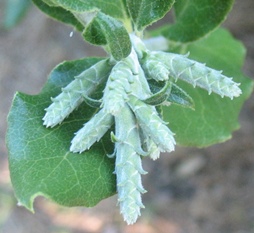
Version 8/4/2020
- Containers should be brushed or rinsed to remove as much
potting media as possible before treatment.
- Containers must be unstacked or loosely stacked so that the solution can
circulate freely to all portions of the pots.
- Sanitizing solutions shall be freshly made or tested to ensure target
concentrations.
- Containers should be fully immersed in the sanitizing solution for at least
the minimum specified time before removing to rinse or dry. Some agitation may
be necessary to break up air bubbles that may keep surfaces from being wetted.
Sodium hypochlorite: Immerse containers in a fresh solution of diluted bleach (0.525% sodium hypochlorite, Table 1) for a minimum of 5 minutes. Solutions must be made fresh and replaced if contaminated with substantial amounts of organic debris. Chlorine concentrations should be tested before reuse (e.g., using commercial test strips) and should be no lower than 5000 ppm in the solution being used.
Quaternary ammonium compounds: As discussed in section 1.1.1., these materials must be used at the concentration and exposure time described on the product label. Concentration should be tested before reuse (e.g., using commercial test strips) and replenished or replaced in accordance with label specifications to attain the required concentration. Exposure times listed on labels are minimums and may not be sufficient to kill all types of Phytophthora spores; check the label for specific efficacy claims.
If residues on containers are moist, heating to a temperature of at least 122°F (50°C) for at least 30 minutes will kill propagules of many, but possibly not all, Phytophthora species. To provide for a margin of safety and to obtain kill of other plant pathogenic fungi, containers with moist residues should be heated to 140°F (60°C) or higher for at least 30 minutes. If residues are dry, treatment temperature should be at least 160°F (71°C). All portions of the treated containers must be maintained at the target temperature for 30 minutes. Note that timing should start when the coolest portions of the treated containers have reached the target temperature.
Temperature should be monitored using thermometers or thermocouples placed among the parts of the containers that will be slowest to heat. Heat may be applied by any of several methods as long as the target temperatures can be maintained for the necessary duration. Loosely stacked containers may be treated using steam or aerated steam in a closed container. Direct solar heating can be used by wrapping moistened containers in clear plastic and laying them horizontally on a clean surface to maximize solar exposure. Greater solar heating may be obtained in a solar oven, i.e., a closed, insulated container with a glass or clear plastic top. More uniform heating will be obtained if hot air can circulate around the containers.
Containers can also be heat treated by submerging them in water that is maintained at 160°F (71 C) or higher for a minimum of 30 minutes. Once containers are submerged, timing of the treatment period should begin when water temperature throughout the treatment tank has reached the target temperature. Container stacking should be loose enough to allow all surfaces to become fully wetted and avoid air pockets.
Surfaces and tools should be clean and sanitized before use. Tools and working surfaces (e.g., potting benches) should be smooth and nonporous to facilitate cleaning and sanitation. Wood handles on tools should be sealed with a waterproof coating to make them easier to sanitize.
Before sanitizing, all soil and organic material (roots, sap, etc.) should be removed from the surface. If necessary, use a detergent solution and brush to scrub off surface contaminants.
The following materials can be used to sanitize tools or
surfaces that are clean and free of surface water. As noted above, if treated
surfaces are wet, the sanitizing solution will be diluted:
- 70-90% ethyl or isopropyl alcohol - spray to thoroughly wet and allow to air
dry before use
- freshly diluted bleach solution (0.525% sodium hypochlorite, Table 1) for a
minimum of 1 minute (due to corrosivity, not advised for steel or other
materials damaged by bleach)
- quaternary ammonium disinfectant - use according to
manufacturer recommendations - freshly made or tested to ensure target
concentrations, discussion of quaternary ammonium compounds is here
- for hydrogen dioxide products, follow label instructions for treating
greenhouse surfaces and equipment, allowing sufficient contact time for
disinfecting.
8/4/2020 - Corrected typo in sodium hypochlorite section paragraph of section 2.2.1 - 2000 ppm was listed in error; has been corrected to 5000 ppm. Additional small wording edits.